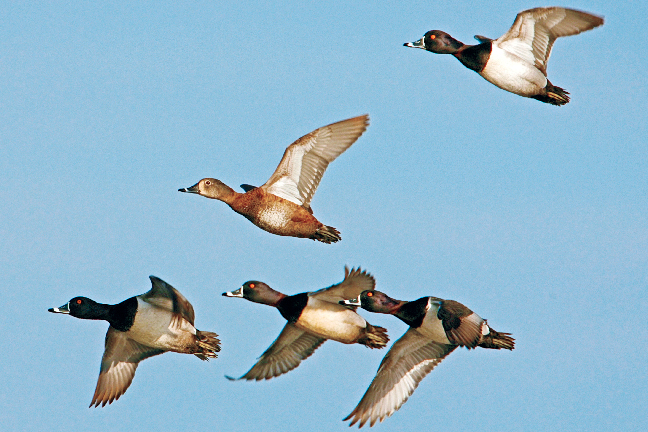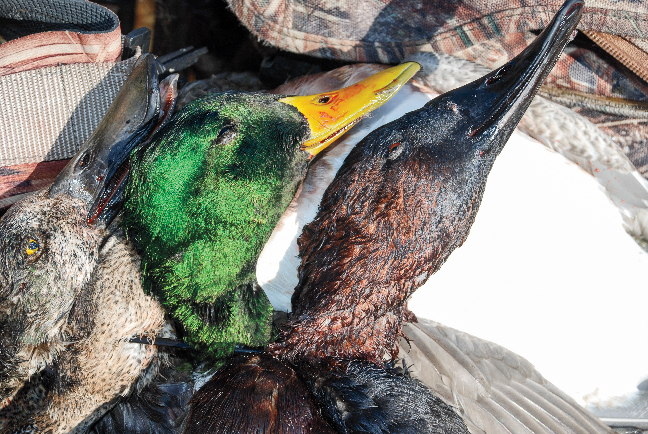On the edge of the Prairie Pothole Region looms a buffetof trophy ducks on public land that hardly anyone hunts.

Poet William Cowper is credited with first saying, “Variety is the spice of life.” I emphatically embrace his words, especially when it pertains to duck hunting. Not only do you hunt ducks in a variety of environs, from marshes and flooded timber to rice fields and sloughs and Great Lakes estuaries, but many times you never know what variety of ducks will show up.
Go Canada goose hunting and you’re going to shoot a big honker or a smaller cackler — they are going to look pretty much identical, one’s just bigger than the other. With ducks it’s different. They come in all kinds of species, sizes and configurations. It’s that variety Cowper described that makes the waterfowling life special.

I don’t know of a region that produces more species of birds than the Sand Hills of Nebraska. It might be because of its location between the Prairie Pothole Region and more southern migration destinations, or that it hosts a potpourri of nesting waterfowl. I’ve shot wood ducks there even though there is a scarcity of trees. For a three-week period in late October through mid-November you can harvest a redhead, can, bluebill, butterball and whistler in the same day if you put your mind to it. It’s not a big deal to shoot four or five different puddlers in the same morning. My friend even shot a wayward surf scoter one day on a Sand Hills lake.
The waterfowl cornucopia is one thing that makes the Sand Hills in the northwest corner of Nebraska unique. The other is opportunity. This region is capable of growing cattle, mule deer, sharp-tails, yucca, ducks and little else. Look out across the vast rolling sea of grass and prairie and you’d get the impression that there’s nothing out there for duck hunters. Closer inspection reveals spring-fed ponds, cattle tanks, seasonal flooding and cattail-ringed sloughs between the folds of the grassy hills. Those waterways host a surprising number of nesting waterfowl, especially when the PPR is dry, and a glut of waterfowl peak during the fall migration. And the best part is that few waterfowlers know or take advantage of the opportunity.
Plenty of Access
Most important to hunters are many square miles of public land.

“There’s lots of water in the Sand Hills this year,” advised Nebraska Game & Parks Waterfowl Specialist Mark Vrtiska. “A lot of the ponds and lakes are the result of run-off and spring rains, but some are spring-fed. During the years when we have good water conditions nesting tends to be more successful. Probably half the ducks you see early in the season during those years are locally-raised ducks.”
Ducks Unlimited Wildlife Biologist John Denton said that contributions to the fall flight from the Sand Hills are significant. “It’s been estimated that in excess of 200,000 nesting hens utilize the Sand Hills during any given spring. The Sand Hills have been undervalued as spring wetlands and waterfowl habitat in the past. The area makes significant contributions to the overall waterfowl population.”
Denton shared that shallow ponds and sloughs are a buffet for nesting and migrant ducks. “When water levels are high these shallow ponds are filled with aquatic vegetation like smartweed, sedge, duck potato, widgeon grass and wild millet. These same ponds are alive with invertebrates and aquatic insects that ducks prefer.”

The insects and invertebrates are especially important for conditioning and fattening up ducks prior to nesting. Denton said that many waterfowl short stop the traditional Prairie Pothole Region in spring when water conditions are poor and utilize the abundant lakes and potholes and more uniform water conditions found in the Sand Hills instead (good news in years like these when water conditions in the PPR are poor).
The contributions to the overall waterfowl population in the Central Flyway would be even more significant if nesting waterfowl in the Sand Hills were a little more successful.
“Studies have shown that first-year nesting females have limited success,” said Vrtiska. “They are just not as successful as nesters in say, the Prairie Pothole Region in spite of good nesting conditions and habitat. That might be because predation is high in the Sand Hills.”
Vrtiska said that an unusually high number of bull snakes account for poor nest mortality. Add the losses from other nest raiders like skunks, mink, raccoons and attacks on nesting females from owls, hawks, eagles and coyotes, and nesting success in not as high as biologists would like.
Still, the contributions are significant. The region produces bumper crops of mallards, blue-wing teal, gadwall, pintails and shovelers most years. Cans and redheads…





